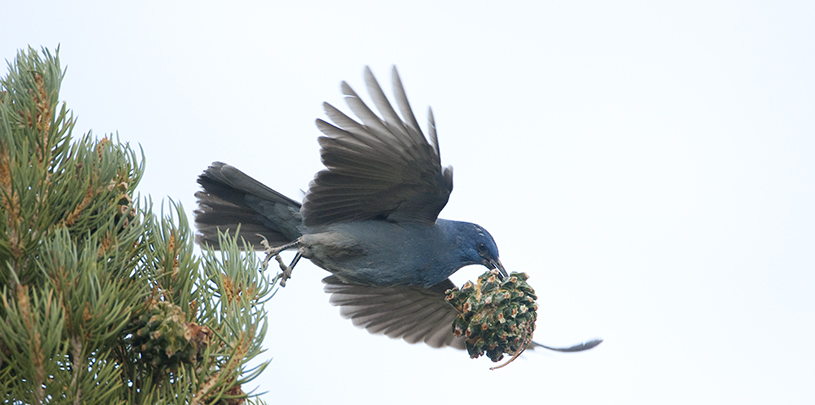
 by Audrey Kruse, Community Engagement Director
by Audrey Kruse, Community Engagement Director
“Kawaa-waa-aa” — a quavering call rings out against the bright blue sky as we hopscotch between shade patches in the pinyon and juniper forest. Everyone freezes and looks around. That was the sound of a pinyon jay, and we are here to record the presence of these birds outside of Escalante, Utah. We have hit a lucky break! A volunteer points frantically but silently to a blue-gray bird perched atop a pinyon pine tree. The bird suddenly spreads her wings and takes flight, heading for a nearby sagebrush meadow. We take out our phones to record the sighting and listen attentively for more bird calls.
In order to help protect pinyon jays and their habitat across the Colorado Plateau, we designed a citizen science project that allows folks, with just a bit of training, to go out and document where pinyon jays live. All it requires is a smartphone and a willingness to listen for these distinct bird calls while you’re hiking, biking, and adventuring on the Colorado Plateau (check out some amazing Grand Staircase-Escalante trails).
Learn more and sign up for the project ›
Pinyon and juniper forests, in which pinyon jays reside, are ubiquitous across the West. The jays have an evolutionarily intertwined relationship with the trees. The pines need the jays to harvest and cache their seeds, planting the next generation of pinyon pines. The pinyon jays rely on the plentiful and protein-packed seeds from mature trees to survive throughout the winter.
Pinyon jay populations have declined by 85 percent since 1970, with another 50 percent loss predicted by 2036 for the remaining population. Instead of increased protection of the birds’ habitat, federal agencies that manage pinyon and juniper forests undertake forest removal projects, to the tune of tens of thousands of acres. Forest managers will sometimes replant the barren ground with non-native grasses that serve as good forage for cows. Effectively, this replaces highly functional forests with feedlots. Most of the proposed pinyon and juniper destruction is along the lower elevation edges of forests, where trees intersperse with sagebrush shrubland. It is this “edge habitat” where the pinyon jays preferentially cache, nest, and thrive.
The current federal conservation strategy for the pinyon jay recommends a 500-meter buffer of undisturbed habitat around known breeding colonies. Thus, if we can document where there are pinyon jays, and where they might be breeding, we can advocate for better management, avoid large-scale clear-cutting, and discourage tree removal altogether in areas full of pinyon jays.
To document our pinyon jay observations, we are using eBird, a global bird-observation database hosted by the Cornell Lab of Ornithology, because it is user-friendly and volunteers' data is easily accessible. The agency in Utah responsible for protecting the pinyon jays also uses eBird data to locate existing pinyon jay populations, so we are feeding many birds with one scone, so to speak.
 BLAKE MCCORD
BLAKE MCCORD
We have developed an online training program to teach you how to identify pinyon jays, their characteristic habitat, and several look-a-like birds. You do not need any prior birding experience to contribute to the project — just keen eyes and ears. When you head out on Colorado Plateau excursions, document the pinyon jays you see and hear, and upload your observations when you get back home. We ask that volunteers look for pinyon jays at least four times throughout the year (don’t let winter keep you cooped up inside) — but the more data, the better!
We are especially interested in pinyon jay observations in and around Grand Staircase-Escalante National Monument, where large-scale pinyon and juniper removal projects have happened in the past. We are only able to cover so much ground as one organization, so the power of crowd-sourced science means that we have many eyes and ears out looking for pinyon jays. Plus, we know that analyzing the cumulative impacts of clear-cutting on pinyon jay populations helped protect forests in the past. We used pinyon jay data to help protect over 30,000 acres of forest in Grand Staircase-Escalante National Monument in 2019.
Help us build on that momentum and protect the pinyon and juniper forests, pinyon jays, and all the other creatures that rely on these ancient forests.
As 2024 draws to a close, we look back at five maps we created this year that give us hope for 2025.
Read MoreThe federal government will determine if the charismatic blue bird should be listed as threatened or endangered.
Read MoreWe can’t wait to meet you in a canyon, along a creek, or in the high alpine meadows of the Colorado Plateau.
Read More